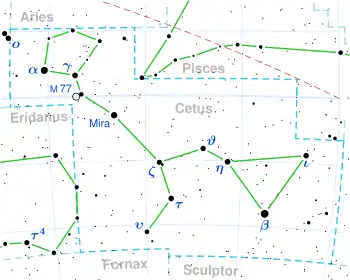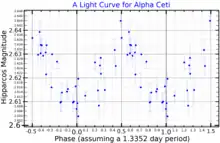Alpha Ceti
Alpha Ceti (α Ceti, abbreviated Alpha Cet, α Cet), officially named Menkar /ˈmɛŋkɑːr/,[8][9] is the second-brightest star in the constellation of Cetus. It is a cool luminous red giant estimated to be about 250 light years away based on parallax.
 | |
| Observation data Epoch J2000 Equinox J2000 | |
|---|---|
| Constellation | Cetus |
| Right ascension | 03h 02m 16.77307s[1] |
| Declination | +04° 05′ 23.0596″[1] |
| Apparent magnitude (V) | 2.53[2] |
| Characteristics | |
| Evolutionary stage | AGB[3] |
| Spectral type | M1.5 IIIa[4] |
| U−B color index | +1.93[2] |
| B−V color index | +1.64[2] |
| Astrometry | |
| Radial velocity (Rv) | −26.08±0.02[5] km/s |
| Proper motion (μ) | RA: −10.41±0.51[1] mas/yr Dec.: −76.85±0.36[1] mas/yr |
| Parallax (π) | 13.09 ± 0.44 mas[1] |
| Distance | 249 ± 8 ly (76 ± 3 pc) |
| Absolute magnitude (MV) | −3.2±0.3[4] |
| Details | |
| Mass | 2.3±0.2[6] M☉ |
| Radius | 89±5[6] R☉ |
| Luminosity | 1,455±328[6] L☉ |
| Surface gravity (log g) | 0.9±0.1[6] cgs |
| Temperature | 3,795±70[6] K |
| Metallicity [Fe/H] | 0.00±0.30[6] dex |
| Rotational velocity (v sin i) | 6.9[7] km/s |
| Other designations | |
| Database references | |
| SIMBAD | data |
Nomenclature
Alpha Ceti is the star's Bayer designation. It has the traditional name Menkar, deriving from the Arabic word منخر manħar "nostril" (of Cetus). In 2016, the International Astronomical Union organized a Working Group on Star Names (WGSN)[10] to catalog and standardize proper names for stars. The WGSN's first bulletin of July 2016[11] included a table of the first two batches of names approved by the WGSN; which included Menkar for this star.
This star, along with γ Cet (Kaffaljidhma), δ Cet, λ Cet (also Menkar), μ Cet, ξ1 Cet and ξ2 Cet were Al Kaff al Jidhmah, "the Part of a Hand".[12]
In Chinese, 天囷 (Tiān Qūn), meaning Circular Celestial Granary, refers to an asterism consisting of α Ceti, κ1 Ceti, λ Ceti, μ Ceti, ξ1 Ceti, ξ2 Ceti, ν Ceti, γ Ceti, δ Ceti, 75 Ceti, 70 Ceti, 63 Ceti and 66 Ceti. Consequently, the Chinese name for α Ceti itself is 天囷一 (Tiān Qūn yī, English: the First Star of Circular Celestial Granary.)[13]
Structure

Despite having the Bayer designation α Ceti, at visual magnitude 2.54 this star is actually not the brightest star in the constellation Cetus. That honor goes instead to Beta Ceti at magnitude 2.04. Menkar is a red giant with a stellar classification of M1.5 IIIa. It has more than twice the mass of the Sun and, as a giant star has expanded to about 89 times the Sun's radius. The large area of the photosphere means that it is emitting about 1,455 times as much energy as the Sun, even though the effective temperature is only 3,795 K (compared to 5,778 K on the Sun). The relatively low temperature gives Menkar the red hue of an M-type star.[16]
Menkar has evolved from the main sequence after exhausting the hydrogen at its core. It has also exhausted its core helium, becoming an asymptotic giant branch star,[3] and will probably become a highly unstable star like Mira before finally shedding its outer layers and forming a planetary nebula, leaving a relatively large white dwarf remnant.[17] It has been observed to periodically vary in brightness, but only with an amplitude of about one hundredth of a magnitude.[15]
Namesakes
Menkar (AK-123) was a United States Navy Crater class cargo ship named after the star.
See also
References
- van Leeuwen, F. (November 2007), "Validation of the new Hipparcos reduction", Astronomy and Astrophysics, 474 (2): 653–664, arXiv:0708.1752, Bibcode:2007A&A...474..653V, doi:10.1051/0004-6361:20078357, S2CID 18759600
- Johnson, H. L.; et al. (1966), "UBVRIJKL photometry of the bright stars", Communications of the Lunar and Planetary Laboratory, 4 (99): 99, Bibcode:1966CoLPL...4...99J
- Eggen, Olin J. (1992), "Asymptotic giant branch stars near the sun", The Astronomical Journal, 104: 275, Bibcode:1992AJ....104..275E, doi:10.1086/116239
- Tsuji, T. (October 2008), "Cool luminous stars: the hybrid nature of their infrared spectra", Astronomy and Astrophysics, 489 (3): 1271–1289, arXiv:0807.4387, Bibcode:2008A&A...489.1271T, doi:10.1051/0004-6361:200809869, S2CID 19007399
- Famaey, B.; et al. (January 2005), "Local kinematics of K and M giants from CORAVEL/Hipparcos/Tycho-2 data. Revisiting the concept of superclusters", Astronomy and Astrophysics, 430 (1): 165–186, arXiv:astro-ph/0409579, Bibcode:2005A&A...430..165F, doi:10.1051/0004-6361:20041272, S2CID 17804304
- Wittkowski, M.; et al. (December 2006), "Tests of stellar model atmospheres by optical interferometry. IV. VINCI interferometry and UVES spectroscopy of Menkar", Astronomy and Astrophysics, 460 (3): 855–864, arXiv:astro-ph/0610150, Bibcode:2006A&A...460..855W, doi:10.1051/0004-6361:20066032, S2CID 16525827
- Massarotti, Alessandro; et al. (January 2008), "Rotational and Radial Velocities for a Sample of 761 HIPPARCOS Giants and the Role of Binarity", The Astronomical Journal, 135 (1): 209–231, Bibcode:2008AJ....135..209M, doi:10.1088/0004-6256/135/1/209, S2CID 121883397
- Kunitzsch, Paul; Smart, Tim (2006). A Dictionary of Modern star Names: A Short Guide to 254 Star Names and Their Derivations (2nd rev. ed.). Cambridge, Massachusetts: Sky Pub. ISBN 978-1-931559-44-7.
- "IAU Catalog of Star Names". Retrieved 28 July 2016.
- "IAU Working Group on Star Names (WGSN)". Retrieved 22 May 2016.
- "Bulletin of the IAU Working Group on Star Names, No. 1" (PDF). Retrieved 28 July 2016.
- Star Name - R.H. Allen p.160
- (in Chinese) AEEA (Activities of Exhibition and Education in Astronomy) 天文教育資訊網 2006 年 7 月 11 日
- "/ftp/cats/more/HIP/cdroms/cats". Centre de Données astronomiques de Strasbourg. Strasbourg astronomical Data Center. Retrieved 15 October 2022.
- Koen, Chris; Eyer, Laurent (2002), "New periodic variables from the Hipparcos epoch photometry", Monthly Notices of the Royal Astronomical Society, 331 (1): 45, arXiv:astro-ph/0112194, Bibcode:2002MNRAS.331...45K, doi:10.1046/j.1365-8711.2002.05150.x
- "The Colour of Stars", Australia Telescope, Outreach and Education, Commonwealth Scientific and Industrial Research Organisation, December 21, 2004, archived from the original on March 18, 2012, retrieved 2012-01-16
- Kaler, James B., "MENKAR (Alpha Ceti)", Stars, University of Illinois, retrieved 2011-12-24